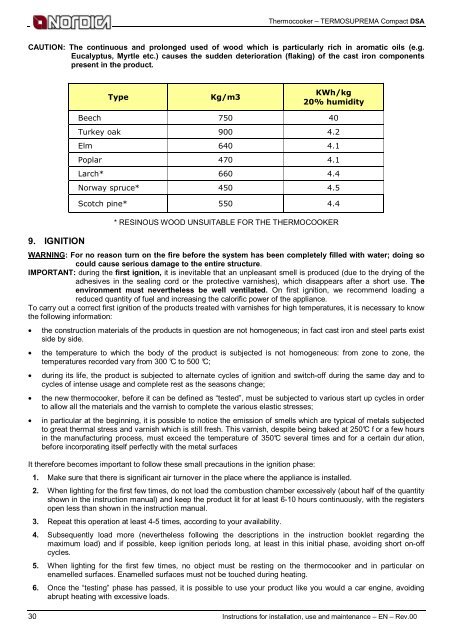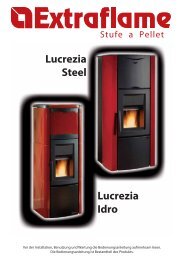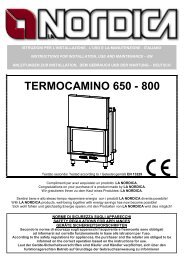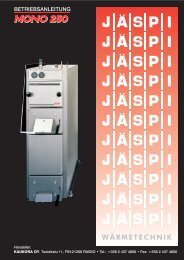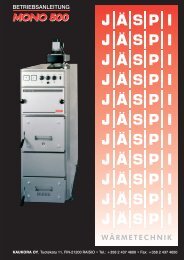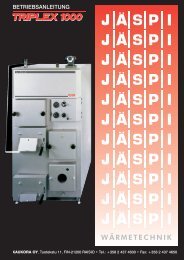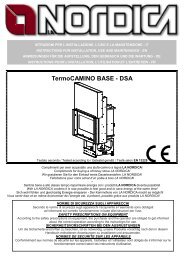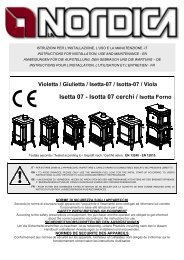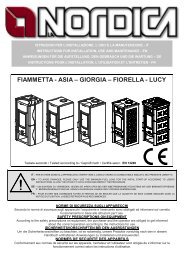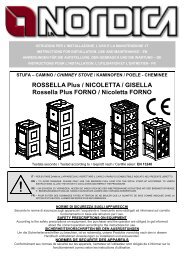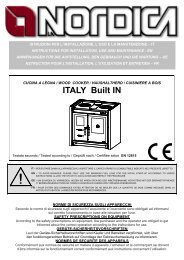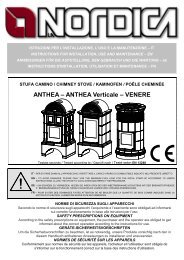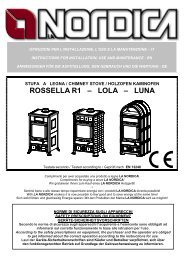TERMOSUPREMA Compact - DSA
TERMOSUPREMA Compact - DSA
TERMOSUPREMA Compact - DSA
Create successful ePaper yourself
Turn your PDF publications into a flip-book with our unique Google optimized e-Paper software.
Thermocooker – <strong>TERMOSUPREMA</strong> <strong>Compact</strong> <strong>DSA</strong><br />
CAUTION: The continuous and prolonged used of wood which is particularly rich in aromatic oils (e.g.<br />
Eucalyptus, Myrtle etc.) causes the sudden deterioration (flaking) of the cast iron components<br />
present in the product.<br />
Type<br />
Kg/m3<br />
KWh/kg<br />
20% humidity<br />
9. IGNITION<br />
Beech 750 40<br />
Turkey oak 900 4.2<br />
Elm 640 4.1<br />
Poplar 470 4.1<br />
Larch* 660 4.4<br />
Norway spruce* 450 4.5<br />
Scotch pine* 550 4.4<br />
* RESINOUS WOOD UNSUITABLE FOR THE THERMOCOOKER<br />
WARNING: For no reason turn on the fire before the system has been completely filled with water; doing so<br />
could cause serious damage to the entire structure.<br />
IMPORTANT: during the first ignition, it is inevitable that an unpleasant smell is produced (due to the drying of the<br />
adhesives in the sealing cord or the protective varnishes), which disappears after a short use. The<br />
environment must nevertheless be well ventilated. On first ignition, we recommend loading a<br />
reduced quantity of fuel and increasing the calorific power of the appliance.<br />
To carry out a correct first ignition of the products treated with varnishes for high temperatures, it is necessary to know<br />
the following information:<br />
• the construction materials of the products in question are not homogeneous; in fact cast iron and steel parts exist<br />
side by side.<br />
• the temperature to which the body of the product is subjected is not homogeneous: from zone to zone, the<br />
temperatures recorded vary from 300 °C to 500 °C;<br />
• during its life, the product is subjected to alternate cycles of ignition and switch-off during the same day and to<br />
cycles of intense usage and complete rest as the seasons change;<br />
• the new thermocooker, before it can be defined as “tested”, must be subjected to various start up cycles in order<br />
to allow all the materials and the varnish to complete the various elastic stresses;<br />
• in particular at the beginning, it is possible to notice the emission of smells which are typical of metals subjected<br />
to great thermal stress and varnish which is still fresh. This varnish, despite being baked at 250°C f or a few hours<br />
in the manufacturing process, must exceed the temperature of 350°C several times and for a certain dur ation,<br />
before incorporating itself perfectly with the metal surfaces<br />
It therefore becomes important to follow these small precautions in the ignition phase:<br />
1. Make sure that there is significant air turnover in the place where the appliance is installed.<br />
2. When lighting for the first few times, do not load the combustion chamber excessively (about half of the quantity<br />
shown in the instruction manual) and keep the product lit for at least 6-10 hours continuously, with the registers<br />
open less than shown in the instruction manual.<br />
3. Repeat this operation at least 4-5 times, according to your availability.<br />
4. Subsequently load more (nevertheless following the descriptions in the instruction booklet regarding the<br />
maximum load) and if possible, keep ignition periods long, at least in this initial phase, avoiding short on-off<br />
cycles.<br />
5. When lighting for the first few times, no object must be resting on the thermocooker and in particular on<br />
enamelled surfaces. Enamelled surfaces must not be touched during heating.<br />
6. Once the “testing” phase has passed, it is possible to use your product like you would a car engine, avoiding<br />
abrupt heating with excessive loads.<br />
30 Instructions for installation, use and maintenance – EN – Rev.00


